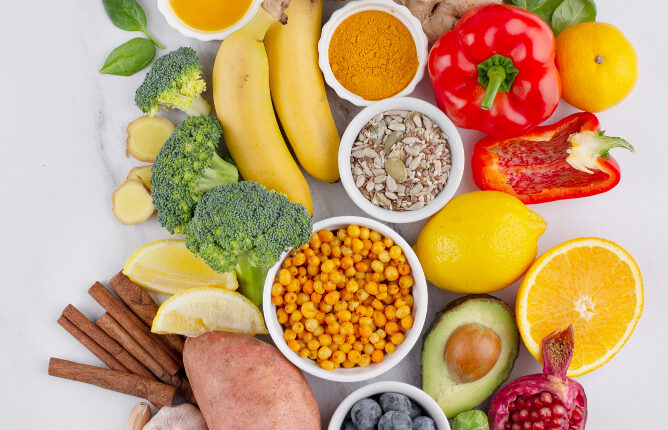Phytonutrients, also known as phytochemicals, are natural compounds found in plants that provide numerous health benefits. Unlike vitamins and minerals, phytonutrients are not essential for life, but they play a significant role in promoting overall health and preventing diseases. This blog will explore what phytonutrients are, their various types, and their health benefits.
Understanding Phytonutrients
Phytonutrients are bioactive compounds that give plants their colour, flavour, and resistance to diseases. Discover these vital nutrients in a variety of foods: fruits, veggies, grains, legumes, nuts, and teas. Among the multitude of phytonutrients, some of the heavy hitters are flavonoids, carotenoids, and polyphenols.
Types of Phytonutrients
1. Flavonoids
Flavonoids are a large group of phytonutrients found in various fruits and vegetables. They have potent antioxidant properties and help protect cells from damage. Common sources of flavonoids include berries, apples, onions, and tea.
2. Carotenoids
Carotenoids are pigments responsible for the red, orange, and yellow colours in many fruits and vegetables. They have antioxidant properties and are essential for eye health. Beta-carotene, lycopene, and lutein are well-known carotenoids found in carrots, tomatoes, and leafy greens.
3. Polyphenols
Polyphenols are like the superheroes of the plant world, packed with powerful antioxidant properties. They are found in foods like grapes, berries, tea, and dark chocolate. Polyphenols are known for their anti-inflammatory and heart-protective effects.
4. Glucosinolates
Glucosinolates are amazing sulfur-containing compounds that are packed into healthy cruciferous vegetables like broccoli, cabbage, and Brussels sprouts. They have been shown to have cancer-fighting properties by helping detoxify the body and protect against cellular damage.
5. Phytoestrogens
Phytoestrogens are amazing plant compounds that have the remarkable ability to mimic the action of estrogen in the body. Check out these nutrient-packed foods like soy, flaxseeds, and sesame seeds. Phytoestrogens can help balance hormone levels and reduce the risk of hormone-related cancers.

Health Benefits of Phytonutrients
1. Antioxidant Protection
Phytonutrients have strong antioxidant properties that help protect cells from oxidative stress. By neutralizing free radicals, they reduce the risk of chronic diseases such as heart disease, cancer, and diabetes.
2. Anti-Inflammatory Effects
Numerous phytonutrients contain powerful anti-inflammatory properties that actively work to reduce inflammation within the body. Persistent inflammation has been associated with a range of health concerns, such as arthritis, heart disease, and specific types of cancer. Consuming phytonutrient-rich foods can help lower inflammation levels.
3. Heart Health
Phytonutrients like flavonoids and polyphenols support heart health by improving blood vessel function, reducing blood pressure, and lowering LDL cholesterol levels. Regular consumption of fruits, vegetables, and whole grains can significantly reduce the risk of heart disease.
4. Cancer Prevention
Specific phytonutrients, such as glucosinolates and carotenoids, have been shown to have cancer-fighting properties. They help protect cells from DNA damage, inhibit the growth of cancer cells, and support the body’s detoxification processes.
5. Eye Health
Carotenoids such as lutein and zeaxanthin play a crucial role in keeping your eyes healthy. They help protect the eyes from oxidative damage and reduce the risk of age-related macular degeneration (AMD) and cataracts.
6. Hormone Balance
Phytoestrogens can help balance hormone levels, particularly in women. They may reduce symptoms of menopause, such as hot flashes, and lower the risk of hormone-related cancers like breast and prostate cancer.
How to Include Phytonutrients in Your Diet
Incorporating a variety of phytonutrient-rich foods into your diet is key to reaping their health benefits. Here are some tips:
Eat a Rainbow: Include a wide range of colourful fruits and vegetables in your meals. Each colour represents different phytonutrients and health benefits.
Add Herbs and Spices: Herbs and spices like turmeric, ginger, and garlic are rich in phytonutrients and can enhance the flavour and health benefits of your meals.
Choose Whole Foods: Opt for whole grains, nuts, seeds, and legumes instead of processed foods to ensure a higher intake of phytonutrients.
Drink Tea: Green, black, and herbal teas are packed with polyphenols and other beneficial phytonutrients. Enjoy a cup of tea daily to boost your intake.
Incorporate Cruciferous Vegetables: To benefit from glucosinolates, include broccoli, Brussels sprouts, cabbage, and kale in your diet.
Conclusion
Phytonutrients are powerful compounds found in plant-based foods that offer numerous health benefits. From protecting against oxidative stress and inflammation to supporting heart health and cancer prevention, phytonutrients play a crucial role in maintaining overall well-being. By incorporating a variety of colourful fruits, vegetables, whole grains, and teas into your diet, you can harness the power of phytonutrients and enjoy a healthier life.









